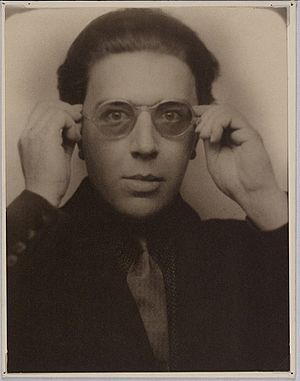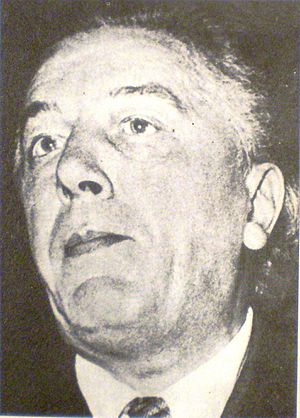André Breton facts for kids
Quick facts for kids
André Breton
|
|
|---|---|

Breton in 1924
|
|
| Born | André Robert Breton 19 February 1896 Tinchebray, France |
| Died | 28 September 1966 (aged 70) Paris, France |
| Occupation | Writer |
| Period | 20th century |
| Genre | Histories, poetry, essays |
| Literary movement | Surrealism |
| Notable works | Surrealist Manifesto |
| Spouse |
Simone Kahn
(m. 1921; div. 1931)Elisa Bindhoff Enet
(m. 1945–1966) |
| Children | Aube Breton |
| Signature | |
André Robert Breton (born February 19, 1896 – died September 28, 1966) was a famous French writer and poet. He was a key figure in starting and leading the art movement called Surrealism.
Breton wrote the first Surrealist Manifesto in 1924. In this important book, he described Surrealism as "pure psychic automatism." This meant letting your mind create freely, without thinking too much.
He also wrote other well-known books like Nadja and L'Amour fou. His work helped shape French art and literature in the 20th century.
Contents
André Breton's Life Story
André Breton was born in Tinchebray, France. He was the only child in a family that didn't have a lot of money. His father, Louis-Justin Breton, was a policeman. His mother, Marguerite-Marie-Eugénie Le Gouguès, used to be a seamstress.
Breton studied to become a doctor. He became very interested in how the mind works and in mental health. His studies were paused when he joined the army during World War I.
Early Experiences and Influences
During World War I, Breton worked in a hospital ward for people with nerve problems in Nantes. There, he met Jacques Vaché. Vaché had a strong dislike for traditional art and society. This way of thinking greatly influenced Breton. Vaché passed away at age 23. His wartime letters were later published, and Breton wrote introductions for them.
Breton married his first wife, Simone Kahn, in 1921. They moved to an apartment in Paris. This apartment became home to Breton's huge collection of over 5,300 items. These included modern paintings, drawings, sculptures, photos, books, and art from different cultures.
From Dada to Surrealism
In 1919, Breton started a magazine called Littérature with his friends Louis Aragon and Philippe Soupault. He also worked with Dada artists like Tristan Tzara. Dada was an art movement that challenged traditional ideas.
In 1924, Breton helped create the Bureau of Surrealist Research. This was a place for artists and writers to explore new ideas.
He and Soupault wrote Les Champs Magnétiques (The Magnetic Fields). In this work, they used "automatic writing." This is a technique where you write quickly without planning, letting your subconscious mind guide you.
Breton published the Surrealist Manifesto in 1924. He also edited the magazine La Révolution surréaliste. Many writers joined him, including Soupault, Aragon, Paul Éluard, and Antonin Artaud.
Breton wanted to combine the idea of personal change with the political ideas of Karl Marx. He joined the French Communist Party in 1927 but was later asked to leave in 1933.
In 1928, he published Nadja. This novel was about his meeting with an imaginative woman. Breton also celebrated the idea of "Mad Love," which was about passionate and freeing love. Many women artists joined the Surrealist group over the years, including Toyen. Breton often supported himself by selling paintings from his art gallery.
In 1929, Breton released his Second manifesto of surrealism. This book contained a controversial sentence about shocking actions. Some writers and artists disagreed with Breton's leadership. They published a collection of writings against him called Un Cadavre. This showed a split among the early Surrealists.
In 1935, Breton had a disagreement with a Soviet writer, Ilya Ehrenburg, at a writers' conference in Paris. This led to the Surrealists being removed from the meeting.
In 1938, the French government sent Breton to Mexico for a cultural project. After getting a bit lost in Mexico City, he famously said, "Mexico is the most surrealist country in the world." While in Mexico, he met Leon Trotsky, a Russian revolutionary. Together, Breton and Trotsky wrote the Manifesto for an Independent Revolutionary Art. This manifesto called for complete freedom in art, which was important during that time. Artists like Diego Rivera and Frida Kahlo also visited them.
World War II and Exile
When World War II began, Breton again served in the medical corps of the French Army. His writings were banned by the French government at the time. With help from others, Breton escaped to the United States and the Caribbean in 1941. He lived in New York City for several years.
In 1942, Breton helped organize an important Surrealist art show at Yale University. He also worked with artist Wifredo Lam on his poem "Fata Morgana."
During his time away, he met Aimé Césaire, a writer from Martinique. He also met Elisa Bindhoff, a woman from Chile who became his third wife.
In 1944, Breton and Elisa traveled to Quebec, Canada. There, he wrote Arcane 17. This book shared his worries about World War II. It also described the beauty of the Percé Rock and celebrated his new relationship with Elisa.
From 1945 to 1946, Breton visited Haiti. He was interested in connecting Surrealist ideas with the history of the Haitian Revolution and the spiritual practices of Haitian Vodou. He was very impressed by Haitian painting, especially the work of Hector Hyppolite, a Vodou priest and painter. Breton believed Hyppolite was the first artist to truly show Vodou scenes in his art. Breton's writings helped Hyppolite become known around the world.
Breton's visit to Haiti happened during a time of political change. His talks there were popular with young artists and students. They used his ideas to support their own revolutionary movement. This movement eventually led to the overthrow of the country's president. Breton later said that the Haitian people's suffering was the main reason for the revolt.
Later Life
Breton returned to Paris in 1946. He spoke out against French colonialism. He also continued to support and guide a new group of Surrealist artists through exhibitions and magazines.
After World War II, André Breton openly supported anarchism. This is a political idea that believes in self-governed societies without a ruling government. He supported the Anarchist Federation in France. He continued to work with anti-fascist groups in the 1960s.
André Breton passed away in 1966 at the age of 70. He was buried in the Cimetière des Batignolles in Paris.
Breton as a Collector
Breton loved collecting art, items from different cultures, and unique objects. He was especially interested in things from the northwest coast of North America.
In 1931, he faced money problems, and much of his collection was sold. However, he rebuilt his collection in his home at 42 rue Fontaine. It grew to include over 5,300 items. These included modern paintings, drawings, sculptures, photographs, books, and art from around the world.
After Breton's death, his wife Elisa and daughter Aube allowed students and researchers to see his collection. Later, in 2003, the collection was sold at auction. A part of his apartment wall, which held some of his collection, is now kept at the Centre Georges Pompidou in Paris.
In 2008, nine of his writings that had never been published before were sold at auction. This included an early version of the Manifeste du surréalisme.
Personal Life
André Breton was married three times:
- From 1921 to 1931, to Simone Collinet.
- From 1934 to 1943, to Jacqueline Lamba. They had one daughter named Aube Breton.
- From 1945 until his death in 1966, to Elisa Bindhoff Enet.
Works
- 1919: Mont de Piété (Pawn Shop)
- 1920: S'il Vous Plaît (If You Please)
- 1920: Les Champs magnétiques (The Magnetic Fields) (with Philippe Soupault)
- 1923: Clair de terre (Earthlight)
- 1924: Les Pas perdus (The Lost Steps)
- 1924: Manifeste du surréalisme (Surrealist Manifesto)
- 1924: Poisson soluble (Soluble Fish)
- 1924: Un Cadavre (A Corpse)
- 1926: Légitime défense (Legitimate Defense)
- 1928: Le Surréalisme et la peinture (Surrealism and Painting)
- 1928: Nadja (Nadja)
- 1930: Ralentir travaux (Slow Down, Men at Work) (with René Char and Paul Éluard)
- 1930: Deuxième Manifeste du surréalisme (The Second Manifesto of Surrealism)
- 1930: L'Immaculée Conception (Immaculate Conception) (with Paul Éluard)
- 1931: L'Union libre (Free Union)
- 1932: Misère de la poésie (Poetry's Misery)
- 1932: Le Revolver à cheveux blancs (The White-Haired Revolver)
- 1932: Les Vases communicants (Communicating Vessels)
- 1933: Le Message automatique (The Automatic Message)
- 1934: Qu'est-ce que le Surréalisme? (What Is Surrealism?)
- 1934: Point du Jour (Break of Day)
- 1934: L'Air de l'eau (The Air of the Water)
- 1935: Position politique du surréalisme (Political Position of Surrealism)
- 1936: Au Lavoir noir (At the black Washtub)
- 1936: Notes sur la poésie (Notes on Poetry) (with Paul Éluard)
- 1937: Le Château étoilé (The Starry Castle)
- 1937: L'Amour fou (Mad Love)
- 1938: Trajectoire du rêve (Trajectory of Dream)
- 1938: Dictionnaire abrégé du surréalisme (Abridged Dictionary of Surrealism) (with Paul Éluard)
- 1938: Pour un art révolutionnaire indépendant (For an Independent Revolutionary Art) (with Diego Rivera)
- 1940: Anthologie de l'humour noir (Anthology of Black Humor)
- 1941: "Fata Morgana" (a long poem)
- 1943: Pleine Marge (Full Margin)
- 1944: Arcane 17 (Arcanum 17)
- 1945: Le Surréalisme et la peinture (Surrealism and Painting)
- 1945: Situation du surréalisme entre les deux guerres (Situation of Surrealism between the two wars)
- 1946: Yves Tanguy
- 1946: Les Manifestes du surréalisme (Manifestoes of Surrealism)
- 1946: Young Cherry Trees Secured against Hares – Jeunes cerisiers garantis contre les lièvres (Bilingual poems)
- 1947: Ode à Charles Fourier (Ode To Charles Fourier)
- 1948: Martinique, charmeuse de serpents (Martinique: Snake Charmer)
- 1948: La Lampe dans l'horloge (The Lamp in the Clock)
- 1948: Poèmes 1919–48 (Poems 1919–48)
- 1949: Flagrant délit (Red-handed)
- 1952 Entretiens (Conversations: The Autobiography of Surrealism)
- 1953: La Clé des Champs (Free Rein)
- 1954: Farouche à quatre feuilles (Four-Leaf Feral) (with Lise Deharme, Julien Gracq, Jean Tardieu)
- 1955: Les Vases communicants (Expanded edition) (Communicating Vessels)
- 1955: Les Manifestes du surréalisme (Expanded edition) (Manifestoes of Surrealism)
- 1957: L'Art magique (Magical Art)
- 1959: Constellations (with Joan Miró)
- 1961: Le la (The A)
- 1962: Les Manifestes du surréalisme (Expanded edition) (Manifestoes of Surrealism)
- 1963: Nadja (Expanded edition) (Nadja)
- 1965: Le Surréalisme et la peinture (Expanded edition) (Surrealism and Painting)
- 1966: Anthologie de l'humour noir (Expanded edition) (Anthology of Black Humor)
- 1966: Clair de terre (Anthology of poems 1919–1936) (Earthlight)
- 1968: Signe ascendant (Anthology of poems 1935–1961) (Ascendant Sign)
- 1970: Perspective cavalière (Cavalier Perspective)
- 1988: Breton : Oeuvres complètes, tome 1 (Breton: The Complete Works, volume 1)
- 1992: Breton : Oeuvres complètes, tome 2 (Breton: The Complete Works, volume 2)
- 1999: Breton : Oeuvres complètes, tome 3 (Breton: The Complete Works, volume 3)
See Also
 In Spanish: André Breton para niños
In Spanish: André Breton para niños
- Anti-art
- Hector Hyppolite
Images for kids


